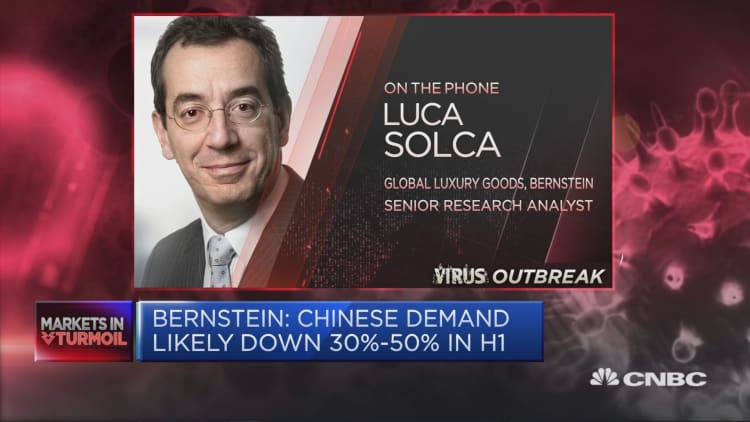It's hard to erase the memory of red-and-white sale signs in the world's most prestigious stores on Madison Avenue, New York, at the end of 2008.
Stores that rarely offered discounts in their flagships, slashed prices to move stock to very few shoppers.
The luxury sector is not quite witnessing the same carnage as the financial crisis yet but it's coming. Luxury customers from countries across the world have been hit simultaneously with an economic crisis, job losses, travel restrictions and volatile oil prices.
Luca Solca, a senior research analyst for the Global Luxury Goods Sector at Bernstein, told CNBC last week that first-half numbers will be the worst in history for the sector.
The scenario looks bleaker than 2008, with no offset other than online purchases. Bernstein puts Chinese demand at 35% for the luxury sector, and forecasts a 30% to 50% plunge in revenue in the first half. While the U.S. and Europe make up 40% of demand and will be down materially.

Why have luxury stocks like bellwether LVMH only reset to 2019 levels rather than crashing much lower? The difference this time, according to Solca, is that in the financial crisis, markets thought the world was coming to an end as central banks and governments were not immediately coming to the rescue. This time is different, as authorities have responded quickly.
Earnings valuations and sales forecasts have remained higher than in 2009 and 2003 which means there could be further downside if the pandemic lasts longer than expected and there is no good news on a vaccine, warned Solca.
So how does luxury weather the crisis? The immediate response for luxury firms is to dial back spending on communications to zero and negotiate a rental holiday with landlords, said Solca.
Advertising veterans like Martin Sorrell have already flagged accelerating digital trends. This suggests more pain for department stores, many have been suffering since the financial crisis. Longer term, luxury may scale back their retail footprint particularly if tourist flows remain impacted.
Another source of pain for luxury could be in the supply chain — composed of many small and medium-sized businesses. It is feared some sub-contractors could go out of business.
Luxury prices have escalated rapidly in recent years from highly sought-after Hermes Birkin bags to Gucci clothing which has benefited from the Gucci effect … lots of razzle dazzle by its creative director driving up demand.
But it's hard to see price increases being sustained with so much inventory to shift. Any changes in ticket prices could have a knock-on impact for margins, which have had a huge influence on heady company valuations.
There is no doubt the industry has done its part to support health workers during the pandemic, making masks and hand sanitizer. But goodwill won't be enough to encourage once extravagant customers, aspirational buyers and influencers to part with wads of cash during a recession.


